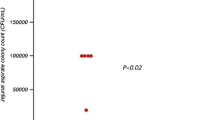Abstract
Background
Small intestinal bacterial overgrowth (SIBO) is regarded as the major risk factor of bacterial translocation. Few studies have investigated the direct relation between SIBO and translocation in cirrhotic patients. The purpose of this study is to examine the correlation between SIBO and bacterial DNA in the peripheral blood of patients with cirrhosis.
Aims
The purpose of this study is to examine the correlation between SIBO and bacterial DNA in the peripheral blood of patients with cirrhosis.
Methods
Fifty-three cirrhosis cases and 42 controls underwent a lactulose breath test (LBT) every 15 min for 180 min. To detect and identify the presence of bacterial DNA fragments in peripheral blood, multiplex polymerase chain reaction (PCR) was performed.
Results
The positive rate of LBT was significantly different between the two groups: 60.4% in the patient group and 28.6% in the controls. The SIBO positive rate was 81.3% in the cirrhosis patients with ascites, which was significantly higher than 51.4% in the cirrhosis patients with no ascites (P = 0.03). Eight of the nine patients (88.9%) who had a history of one or more hepatic encephalopathy was SIBO-positive, which was higher than the patients who had had no hepatic encephalopathy. In the cirrhosis group, 32 patients (60.4%) were SIBO-positive, and ten of them (31.3%) were bacterial DNA-positive. Only one case (4.8%) was bacterial DNA-positive in the absence of SIBO-positive. In a multivariate analysis, only the existence of SIBO was the independent risk factor for bacterial DNA (P = 0.026).
Conclusions
SIBO in cirrhosis patients was observed at a very high frequency, and SIBO showed a high correlation with bacterial translocation, suggesting that SIBO could be a major risk factor of bacterial translocation, especially in ascitic patients.

Similar content being viewed by others
References
Wiest R, Garcia-Tsao G. Bacterial translocation (BT) in cirrhosis. Hepatology. 2005;41:422–433. doi:10.1002/hep.20632.
Guarner C, Soriano G. Bacterial translocation and its consequences in patients with cirrhosis. Eur J Gastroenterol Hepatol. 2005;17:27–31. doi:10.1097/00042737-200501000-00006.
Gou YZ, Lian JQ, Nie QH. Bacterial translocation and its consequences in patients with liver cirrhosis. Zhonghua Gan Zang Bing Za Zhi. 2006;14:796–797.
Francés R, González-Navajas JM, Zapater P, et al. Translocation of bacterial DNA from Gram-positive microorganisms is associated with a species-specific inflammatory response in serum and ascitic fluid of patients with cirrhosis. Clin Exp Immunol. 2007;150:230–237.
Guarner C, Runyon BA, Young S, Heck M, Sheikh MY. Intestinal bacterial overgrowth and bacterial translocation in cirrhotic rats with ascites. J Hepatol. 1997;26:1372–1378. doi:10.1016/S0168-8278(97)80474-6.
Cirera I, Bauer TM, Navasa M, et al. Bacterial translocation of enteric organisms in patients with cirrhosis. J Hepatol. 2001;34:32–37. doi:10.1016/S0168-8278(00)00013-1.
Yang CY, Chang CS, Chen GH. Small-intestinal bacterial overgrowth in patients with liver cirrhosis, diagnosed with glucose H2 or CH4 breath tests. Scand J Gastroenterol. 1998;33:867–871. doi:10.1080/00365529850171549.
Bauer TM, Steinbrückner B, Brinkmann FE, et al. Small intestinal bacterial overgrowth in patients with cirrhosis: Prevalence and relation with spontaneous bacterial peritonitis. Am J Gastroenterol. 2001;96:2962–2967. doi:10.1111/j.1572-0241.2001.04668.x.
González-Navajas JM, Francés R, Such J. Bacterial DNA in patients with cirrhosis and sterile ascites. Its role as a marker of bacterial translocation and prognostic tool. Rev Esp Enferm Dig. 2007;99:599–603.
Guarner C, González-Navajas JM, Sánchez E, et al. The detection of bacterial DNA in blood of rats with CCI4-induced cirrhosis with ascites represents episodes of bacterial translocation. Hepatology. 2006;44:633–639. doi:10.1002/hep.21286.
Hwang IT, Kim YJ, Kim SH, et al. Annealing control primer system for improving specificity of PCR amplification. Biotechniques. 2003;35:1180–1184.
Lin HC. Small intestinal bacterial overgrowth: A framework for understanding irritable bowel syndrome. JAMA. 2004;292:852–858. doi:10.1001/jama.292.7.852.
Pimentel M, Chow EJ, Lin HC. Normalization of lactulose breath testing correlates with symptom improvement in irritable bowel syndrome. A double-blind, randomized, placebo-controlled study. Am J Gastroenterol. 2003;98:412–419.
Paik CN, Choi MG, Nam KW, et al. The prevalence of small intestinal bacterial overgrowth in Korean patients with irritable bowel syndrome. Kor J Neurogastroenterol Motil. 2007;13:38–44.
Bauer TM, Schwacha H, Steinbrückner B, et al. Diagnosis of small intestinal bacterial overgrowth in patients with cirrhosis of the liver: Poor performance of the glucose breath hydrogen test. J Hepatol. 2000;33:382–386. doi:10.1016/S0168-8278(00)80273-1.
Quigley EM, Quera R. Small intestinal bacterial overgrowth: Roles of antibiotics, prebiotics, and probiotics. Gastroenterology. 2006;130:S78–S90. doi:10.1053/j.gastro.2005.11.046.
Bauer TM, Schwacha H, Steinbrückner B, et al. Small intestinal bacterial overgrowth in human cirrhosis is associated with systemic endotoxemia. Am J Gastroenterol. 2002;97:2364–2370. doi:10.1111/j.1572-0241.2002.05791.x.
Kim YJ, Kwak CI, Gu YY, et al. Annealing control primer system for identification of differentially expressed genes on agarose gels. Biotechniques. 2004;36:424–6, 428, 430 passim.
Chun JY, Kim KJ, Hwang IT, et al. Dual priming oligonucleotide system for the multiplex detection of respiratory viruses and SNP genotyping of CYP2C19 gene. Nucleic Acids Res. 2007;35:e40. doi:10.1093/nar/gkm051.
Heininger A, Binder M, Ellinger A, et al. Effect of comprehensive validation of the template isolation procedure on the reliability of bacteraemia detection by a 16S rRNA gene PCR. Clin Microbiol Infect. 2004;10:452–458. doi:10.1111/j.1469-0691.2004.00877.x.
Nikkari S, McLaughlin IJ, Bi W, et al. Does blood of healthy subjects contain bacterial ribosomal DNA? J Clin Microbiol. 2001;39:1956–1959. doi:10.1128/JCM.39.5.1956-1959.2001.
Francés R, Zapater P, González-Navajas JM, et al. Bacterial DNA in patients with cirrhosis and noninfected ascites mimics the soluble immune response established in patients with spontaneous bacterial peritonitis. Hepatology. 2008;47:978–985. doi:10.1002/hep.22083.
Author information
Authors and Affiliations
Corresponding author
Rights and permissions
About this article
Cite this article
Jun, D.W., Kim, K.T., Lee, O.Y. et al. Association Between Small Intestinal Bacterial Overgrowth and Peripheral Bacterial DNA in Cirrhotic Patients. Dig Dis Sci 55, 1465–1471 (2010). https://doi.org/10.1007/s10620-009-0870-9
Received:
Accepted:
Published:
Issue Date:
DOI: https://doi.org/10.1007/s10620-009-0870-9




